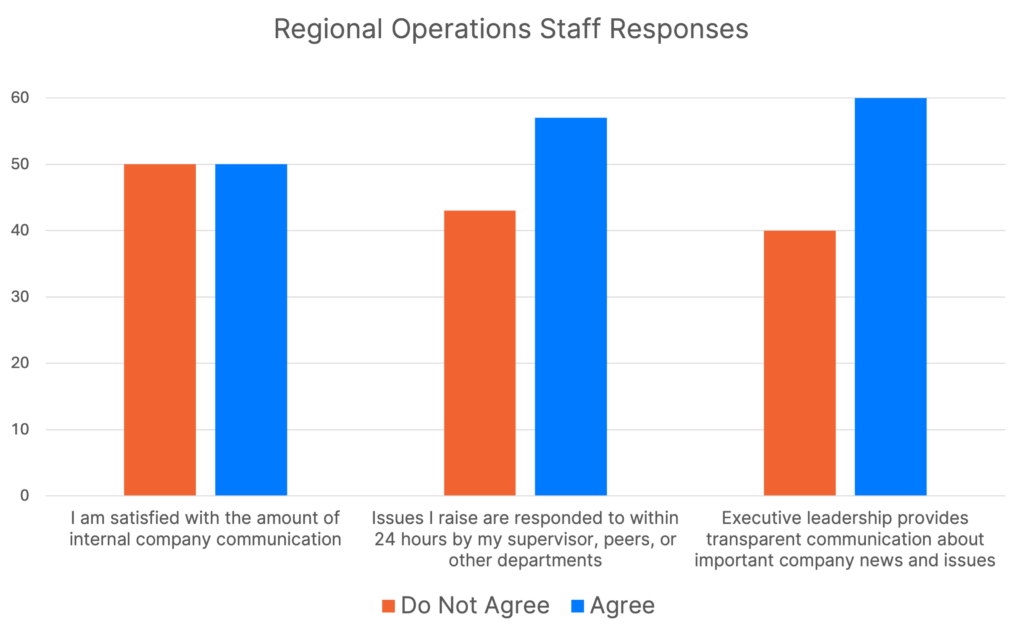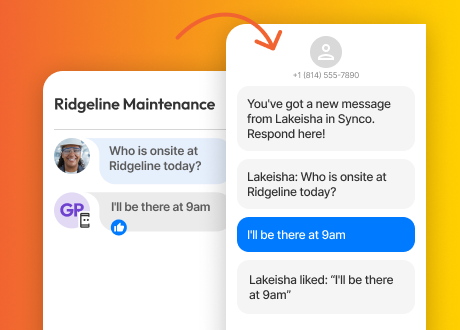This post is based on statistics and research from the Swift Bunny 2024 Employee Engagement Risk Report
In the “always-on” world of property management, effective communication serves as the cornerstone for success. From ensuring smooth operations to fostering a cohesive team environment, communication plays a pivotal role in driving productivity and satisfaction among staff members. But this year’s Employee Engagement Risk Report from Swift Bunny revealed that regional property management staff are more dissatisfied with company communication than other departments, and have a unique set of challenges that impact the way information flows and relationships are maintained.
What Do the Stats Say?
The 2024 Employee Engagement Risk Report posed three key questions to property management employees around company communication, asking them to indicate their agreement or disagreement (Totally Agree, Agree, Neutral, Disagree, Totally Disagree):
On all three of these prompts, regional operations staff had the lowest percentages of agreement when compared to other departments like on-site maintenance, corporate support staff, operations, and more.

This trend of regional operations staff dissatisfaction is worth digging into deeper, as regional managers form a critical bridge between the corporate office and on-site operations at properties.
The Regional Manager’s Role as a Communication Conduit
To understand why regional operations employees are struggling with communication, we need to understand their unique role within a property management team. Regional managers are tasked with managing both upwards and downwards, and find themselves at the heart of a complex web of information dissemination and decision-making.
One of the main reasons for the dissatisfaction among regional staff is the pressure they face in managing these communication streams effectively. They must ensure they have accurate and timely information to answer questions from their team members. If they lack the necessary information, or can’t get answers quickly, or if there is a discrepancy between what they know and what their team members know, it can create frustration for them as supervisors.
Additionally, when a property management company expands and brings on more units, it puts additional strain on regional staff. With increased responsibilities and a growing team, they often feel overwhelmed and struggle to keep up with the demands of their role.
Micro-Communication Challenges
One of the key areas of concern highlighted in the Employee Engagement Risk Report was the dissatisfaction among regional staff regarding response times to specific issues they raise with their supervisors. Ultimately, when issues are not responded to, it means that resident issues take longer to resolve, team members get frustrated, and regional operations staff feel the brunt of that.
“I pride myself on communicating with people above me and people that work directly with me. Unfortunately, the response time from above is lacking and email and questions are not answered for days, sometimes weeks.”
Regional Operations Team Member
The proliferation of multiple communication platforms, from emails to text messages to Teams messages, complicates the day-to-day communication landscape, leading to confusion and inefficiencies. The implementation of new technologies and centralization efforts can make the communication process even harder. While these initiatives aimed to streamline operations, they have sometimes created additional layers of bureaucracy, where regional staff now have to wait for approvals from various departments, leading to delays and bottlenecks in the communication flow.
Macro-Communication Challenges
On the macro-communication side, transparent communication from executive leadership emerged as a crucial point of dissatisfaction among regional staff. While regional staff may be physically closer to the corporate office, it’s not a guarantee that they are well-informed about important company news and issues. This assumption often leads to a lack of transparency and leaves regional staff feeling out of the loop.
“Regional managers want to be able to share company information with their team members and let them know what’s going on. They don’t want to be blindsided by information that’s popping up from the field where they feel, “I should have known about that, I should have been given a heads up from executive leadership.“”
Jen Piccotti, President, Swift Bunny
The Solution: Communicating Transparently & Consistently, At All Levels
Establishing a centralized platform for micro-communication and a cadence for macro-communication that is both informative and engaging can help bridge the gap between leadership and regional operations staff. Balancing the need for timely, efficient updates with the risk of overwhelming employees is essential in fostering a culture of transparency and trust within the organization.
For micro-communication, property management teams are transforming their day-to-day communication with the Synco centralized platform. Not only is real-time messaging (versus email or texting) a faster, more intuitive way to communicate, but centralizing company communication onto one platform gives employees more visibility into what’s happening day-to-day.
To address regional managers’ dissatisfaction with executive leadership communication, those leaders must understand the value of their presence and communication. Transparent and regular communication from top-level executives can significantly impact employee satisfaction and retention. When employees have faith in leadership’s ability to address challenges and make positive changes, they are more likely to remain with the company.
“As an executive, when you bring people together you start to see and understand people’s strengths and you start to see what really drives them, what motivates them. Where could they really help our company, or be a leader in a certain part of our organization, or who’s the subject matter expert in these types of situations?“
Jen Piccotti, President, Swift Bunny
Implementing a regular cadence of communication, whether it be weekly, monthly, or quarterly, can help bridge the gap. For example, some companies hold a weekly 15-minute all-hands meeting, rotating the responsibility among different executives. This brief update allows employees to stay informed, feel connected to leadership, and understand the direction of the company.
To download the Swift Bunny 2024 Employee Engagement Risk Report, please click here.
This article is based on a video interview – to watch a clip from the interview, click below:



